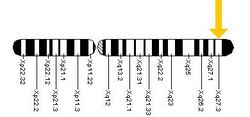FXTAS
FXTAS is Fragile X-associated Tremor/Ataxia Syndrome. This neurological disease was described just few years ago (2001) through the discovery of RNA toxicity. However, the name point to premutation of FMR1 gene, patient with FXTAS do not suffer from fragile X syndrome and they have different symptoms and problems. Unfortunatelly FXTAS can very often looks like Parkinson´s disease and we have to think about it in our differential diagnosis. Most of the patients are being treated for another diseases.
Etiology and Pathogenesis[edit | edit source]
As it was written above, the main cause of development of FXTAS is a premutation of fraxile X syndrome. It means that these people have an increased number of CGG triplets in their DNA (mostly more than 70 repeats).
It is important to say, that normal FMR1 gene contains from 5 to 45 CGG repeats and it is located on X chromosome. Patients with more than 50 and less than 200 repeats suffer from FXTAS. If they exceed the threshold of 200 CGG triples, they have fragile X syndrome.
We know that FMR1 gene is located on X chromosome, so we can also find huge differents between male and female carriers. Most of the patients are men (about 90%) and just few of them women. It is very easy to get understand why. Women have two X-chromosomes in their karyotype, so the influence of mutated chromosome is inhibited by the normal one. Each cell of a woman body have one X-chromosome turn on and one turn-off, so it looks like a mosaic. Women suffer from FXTAS just in case that there is more X-chromosomes with FMR1 premutation turn-on. On the other hand, men have just X-chromosome, so they are affected more often and their symptoms are much worse.
With X-chromosome is also connected a type of inherity. Children of affected woman has 50:50 chance to inherit the premutation. If patient is a man, then all his daughters and none of his sons will get the premutation (son inherits Y-chromosome, daughter X-chromosome). This rules are called X-linked heredity.
Symptoms[edit | edit source]
- kinetic tremor
- ataxia
- memory problems (especially short-memory)
- cognitive disorders
- depression or aggression
- peripheral neuropathy (the lower limbs)
- incontinence
- orthostatic hypotension
Diagnosis[edit | edit source]
Many of FXTAS symptoms are not specific for it, so we have pretty big problem with correct diagnosis. But there is still one specific sign, which we can find on MRI image – brightness in the middle cerebellar peduncles. It is necesarry to say that this MCP sign has especially negative information value. It means that not all the affected people have this brightness. On the other hand, if we find it in patient with typical symptoms, there is very little chance of any other etiology than FXTAS.
What more, we can describe typical patient as a man, usually older than 50 years. This late onset is typical. Sometimes we can also discovered some relatives (children or grandchildren), who suffer from fragile X syndrome. It is not very suprising, if we know that FXTAS is a premutation, so if any offspring transcribes more copies it can lead to an outbreak of a full mutation.
Therapy[edit | edit source]
There is no specific treatment of FXTAS, so the therapy is symptomatic and it is based on drugs. Because this diagnosis was discovered just few years ago, we do not have so many medicaments, which could we offer to patients. Beta-blocker against tremor, donepezil improves cognitive skills or some antidepressants.
The influence of levodopa is a subject of discussion. Sometimes it looks that it helps to the patients, but there is high chance that it is because they suffer from FXTAS and also from Parkinson´s disease at the same time. In this situation levodopa just moderates parkinsonism, but not FXTAS.
Differential Diagnosis[edit | edit source]




